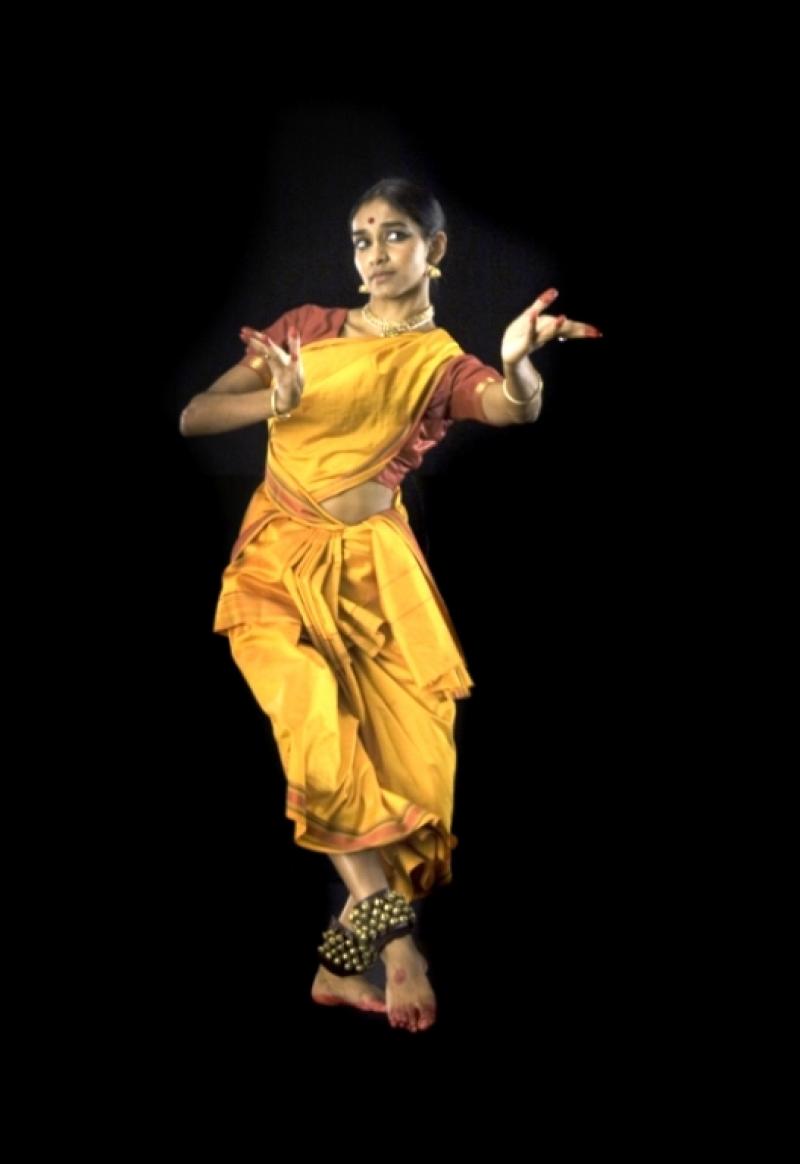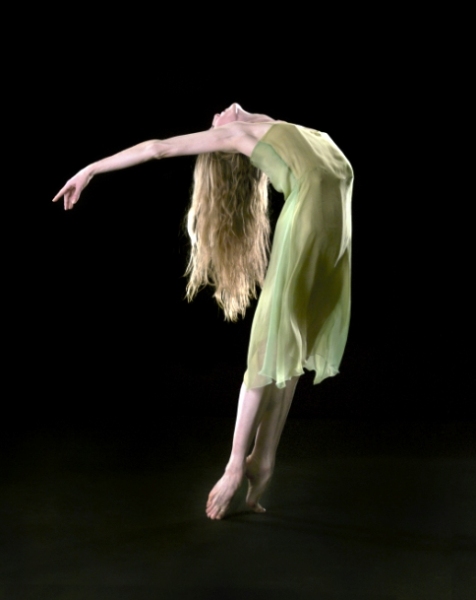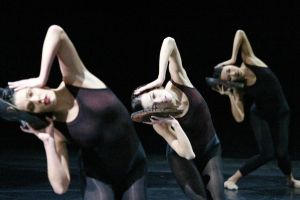David Michalek: Slow Dancing, Trafalgar Square/ Nederlands Dans Theater, Sadler’s Wells | reviews, news & interviews
David Michalek: Slow Dancing, Trafalgar Square/ Nederlands Dans Theater, Sadler’s Wells
David Michalek: Slow Dancing, Trafalgar Square/ Nederlands Dans Theater, Sadler’s Wells
The big screen throws up a thrilling new way of looking at dance

One of the most difficult questions to answer is what makes a great performer great? So much that happens on stage takes place in an eye-blink. Dancer A is "better" than Dancer B, but why? Critics talk about "line", about "extension", about how dancers use and shape space. But it is hard to see shapes in words. Now portrait photographer and installation artist David Michalek has, with one deft blow, solved this problem.
Over 10 minutes, dancers from across the world and across the genres appear blown up on screen to giant proportions, and they appear, at first, to be merely vast posters. Then a gesture; a second; soon the viewers realise that they are watching the creative act itself: here is the essence of those two intangibles, art and technique, merging together to produce performance.
 The styles and content vary wildly. There are dazzling technical virtuosi like American Ballet Theatre's Herman Cornejo and New York City Ballet's Wendy Whelan (pictured right). But there is also Allegra Kent, one of the great New York City Ballet dancers, now in her seventies, who merely bows (albeit more elegantly than one could imagine possible); Judith Jamison, one of the stars of the Alvin Ailey company, and until 1989 its director, also moves little, yet her presence looms large. Other performances are more idiosyncratic: Glen Rumsey, for many years a fine dancer with Merce Cunningham, also has an alter-ego as drag queen Shasta Cola, and here Shasta shows off a really great pair of legs. Whirling Dervish Emine Mira Hunter is breathtakingly focused, mystically serene, and kuchipudi dancer Shantala Shivalingappa (main picture, above) shows off her East-West fusion.
The styles and content vary wildly. There are dazzling technical virtuosi like American Ballet Theatre's Herman Cornejo and New York City Ballet's Wendy Whelan (pictured right). But there is also Allegra Kent, one of the great New York City Ballet dancers, now in her seventies, who merely bows (albeit more elegantly than one could imagine possible); Judith Jamison, one of the stars of the Alvin Ailey company, and until 1989 its director, also moves little, yet her presence looms large. Other performances are more idiosyncratic: Glen Rumsey, for many years a fine dancer with Merce Cunningham, also has an alter-ego as drag queen Shasta Cola, and here Shasta shows off a really great pair of legs. Whirling Dervish Emine Mira Hunter is breathtakingly focused, mystically serene, and kuchipudi dancer Shantala Shivalingappa (main picture, above) shows off her East-West fusion.
The three screens are programmed to cycle randomly, so at the same time the viewer might see an Indonesian dancer, a contemporary performer and a ballet dancer – or three dancers all from the same company, but over several decades. The connections and the dissonances are the viewers’ to make. As well as the dance element, Michalek’s profound photographic eye, and the slow speed, allow the more sculptural elements of both dance and photography to develop – the movement of fabric and skin alone is hauntingly beautiful, while the dense, lush, saturated colours reinforce and recapitulate the light and shade that create shape.
Trafalgar Square big-screen events have sometimes been a bit hit and miss, but the possibilities of installation art are only now being explored. With Slow Dancing, the central plaza has a winner. Not to be missed.
 Meanwhile at Sadler’s Wells, Nederlands Dans Theater is appearing as part of its 50th anniversary tour, with two programmes that recapitulate some of its history. The evening, however, is not really a celebration. While NDT’s choreographers are consumingly interested in emotions, it is rarely the upbeat emotions that preoccupy them. For the most part, the world of NDT is angst-ridden, fascinating and sometimes exhilarating though that can be.
Meanwhile at Sadler’s Wells, Nederlands Dans Theater is appearing as part of its 50th anniversary tour, with two programmes that recapitulate some of its history. The evening, however, is not really a celebration. While NDT’s choreographers are consumingly interested in emotions, it is rarely the upbeat emotions that preoccupy them. For the most part, the world of NDT is angst-ridden, fascinating and sometimes exhilarating though that can be.
The first programme kicks off with Dissolve in This, choreographed by Johan Inger, once an NDT dancer himself, and then for many years director of Sweden’s Cullberg Ballet. It is, unfortunately, a fairly standard piece of identikit Eurodance, with a lot of unresolved relationships and thrumming techno-sound (Ian Andrews’ Ceremonial). As always, NDT’s dancers are technically extraordinary – some of the best in Europe – but even they can make little of this.
Much more appealing is Subject to Change, by NDT’s resident choreographers Paul Lightfoot and Sol León. Lightfood/León’s work has a very recognisable, slick, accessible surface, and frequently there is meat as well. Subject to Change, to Mahler’s rather strange arrangement of Schubert’s Death and the Maiden (played in a shockingly tinny, variable-sounding recording), focuses on a central pair, the charming young Chiaki Horita and her partner Percevale Perks, who play out yet another tormented relationship across a red carpet, manipulated with Kafka-esque overtones by four black-besuited men. The core is slight, but the staging, as ever with this pair, is stylish in the extreme.
The final piece comes from Jiří Kylián, NDT’s director from 1976 to 1992, the man whose work put NDT firmly on the map. Whereabouts Unknown (pictured above), from 1993, has some splendid ensemble work, for both a large women’s corps, who produce a theme and variations on various primitive rhythms, and male soloists, who are given dazzling virtuoso steps which they perform with an almost insolent ease.
NDT, as always, produces an aesthetically smooth, technically and artistically adept evening. It just isn’t much fun.
- Slow Dancing is at Trafalgar Square until 9 July, from 9pm to 1am, and then at Village Underground, Holywell Lane, 13-24 July, Tues-Fri, 1-7pm, Sat and Sun, 10am to 6pm
- NDT is at Sadler’s Wells until 10 July
- Watch some Slow Dancing, and hear the dancers interviewed
- Check out what's on at Sadler's Wells this season
Share this article
The future of Arts Journalism
You can stop theartsdesk.com closing!
We urgently need financing to survive. Our fundraising drive has thus far raised £49,000 but we need to reach £100,000 or we will be forced to close. Please contribute here: https://gofund.me/c3f6033d
And if you can forward this information to anyone who might assist, we’d be grateful.

Subscribe to theartsdesk.com
Thank you for continuing to read our work on theartsdesk.com. For unlimited access to every article in its entirety, including our archive of more than 15,000 pieces, we're asking for £5 per month or £40 per year. We feel it's a very good deal, and hope you do too.
To take a subscription now simply click here.
And if you're looking for that extra gift for a friend or family member, why not treat them to a theartsdesk.com gift subscription?
more Dance
 'We are bowled over!' Thank you for your messages of love and support
Much-appreciated words of commendation from readers and the cultural community
'We are bowled over!' Thank you for your messages of love and support
Much-appreciated words of commendation from readers and the cultural community
 iD-Reloaded, Cirque Éloize, Marlowe Theatre, Canterbury review - attitude, energy and invention
A riotous blend of urban dance music, hip hop and contemporary circus
iD-Reloaded, Cirque Éloize, Marlowe Theatre, Canterbury review - attitude, energy and invention
A riotous blend of urban dance music, hip hop and contemporary circus
 How to be a Dancer in 72,000 Easy Lessons, Teaċ Daṁsa review - a riveting account of a life in dance
Michael Keegan-Dolan's unique hybrid of physical theatre and comic monologue
How to be a Dancer in 72,000 Easy Lessons, Teaċ Daṁsa review - a riveting account of a life in dance
Michael Keegan-Dolan's unique hybrid of physical theatre and comic monologue
 A Single Man, Linbury Theatre review - an anatomy of melancholy, with breaks in the clouds
Ed Watson and Jonathan Goddard are extraordinary in Jonathan Watkins' dance theatre adaptation of Isherwood's novel
A Single Man, Linbury Theatre review - an anatomy of melancholy, with breaks in the clouds
Ed Watson and Jonathan Goddard are extraordinary in Jonathan Watkins' dance theatre adaptation of Isherwood's novel
 Peaky Blinders: The Redemption of Thomas Shelby, Rambert, Sadler's Wells review - exciting dancing, if you can see it
Six TV series reduced to 100 minutes' dance time doesn't quite compute
Peaky Blinders: The Redemption of Thomas Shelby, Rambert, Sadler's Wells review - exciting dancing, if you can see it
Six TV series reduced to 100 minutes' dance time doesn't quite compute
 Giselle, National Ballet of Japan review - return of a classic, refreshed and impeccably danced
First visit by Miyako Yoshida's company leaves you wanting more
Giselle, National Ballet of Japan review - return of a classic, refreshed and impeccably danced
First visit by Miyako Yoshida's company leaves you wanting more
 Quadrophenia, Sadler's Wells review - missed opportunity to give new stage life to a Who classic
The brilliant cast need a tighter score and a stronger narrative
Quadrophenia, Sadler's Wells review - missed opportunity to give new stage life to a Who classic
The brilliant cast need a tighter score and a stronger narrative
 The Midnight Bell, Sadler's Wells review - a first reprise for one of Matthew Bourne's most compelling shows to date
The after-hours lives of the sad and lonely are drawn with compassion, originality and skill
The Midnight Bell, Sadler's Wells review - a first reprise for one of Matthew Bourne's most compelling shows to date
The after-hours lives of the sad and lonely are drawn with compassion, originality and skill
 Ballet to Broadway: Wheeldon Works, Royal Ballet review - the impressive range and reach of Christopher Wheeldon's craft
The title says it: as dancemaker, as creative magnet, the man clearly works his socks off
Ballet to Broadway: Wheeldon Works, Royal Ballet review - the impressive range and reach of Christopher Wheeldon's craft
The title says it: as dancemaker, as creative magnet, the man clearly works his socks off
 The Forsythe Programme, English National Ballet review - brains, beauty and bravura
Once again the veteran choreographer and maverick William Forsythe raises ENB's game
The Forsythe Programme, English National Ballet review - brains, beauty and bravura
Once again the veteran choreographer and maverick William Forsythe raises ENB's game
 Sad Book, Hackney Empire review - What we feel, what we show, and the many ways we deal with sadness
A book about navigating grief feeds into unusual and compelling dance theatre
Sad Book, Hackney Empire review - What we feel, what we show, and the many ways we deal with sadness
A book about navigating grief feeds into unusual and compelling dance theatre
 Balanchine: Three Signature Works, Royal Ballet review - exuberant, joyful, exhilarating
A triumphant triple bill
Balanchine: Three Signature Works, Royal Ballet review - exuberant, joyful, exhilarating
A triumphant triple bill

Add comment